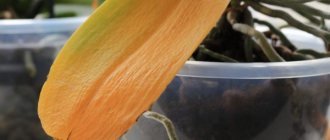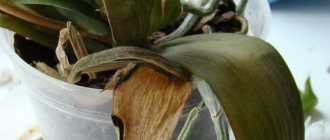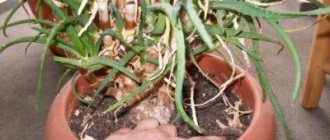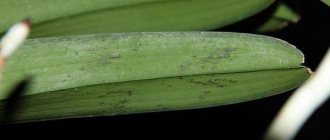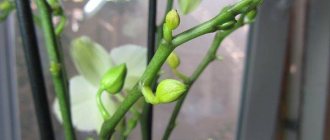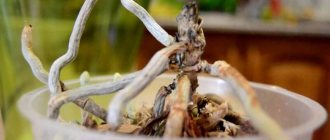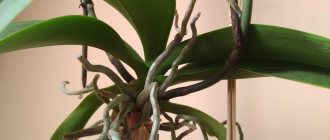What is yellowing?
It happens that orchids turn yellow. This occurs due to various factors affecting the life processes of the plant. As a result, the pigments responsible for the green color are formed in small quantities, and part of the flower changes color. Yellowing affects not only the stem, but the roots, leaves, and peduncle.
Yellowness can appear in one part of the plant, and subsequently affect all organs of the plant.
The appearance of a yellow color indicates ailments or physiological processes.
Read more about why an orchid turns yellow here.
Causes of drying out
Before dwelling on methods for curing orchids, let’s take a closer look at the factors that lead to drying of the roots and yellowing of the leaves.
- The most common cause of drying out is an incorrectly selected soil mixture. Low quality substrate leads to a significant decrease in aeration and cessation of access of micronutrients to aerial roots.
- Incorrect temperature conditions often lead to damage to the orchid . Excessively high daytime temperatures or too low night temperatures create all the necessary preconditions for the underground part to become sick and the entire flower to begin to dry out.
- Another common reason for the death of an orchid is a discrepancy between the size of the flower and the dimensions of the pot . The roots are in a state of development for a significant part of the year, and if the young roots do not find a place for themselves inside the container, they begin to closely intertwine with the old ones, and this causes a noticeable lack of space. As a result, the roots become overdried and give way to new ones.
Consequences for the plant
It’s bad if the stem turns yellow on a young plant, then the cause of aging disappears by itself. The main danger is not to delay treatment , but to react to the first symptoms at the same time. Provide timely assistance to a diseased plant, as the consequences are fraught with:
- complete yellowness and falling off of all leaves;
- drying out of the peduncle;
- deterioration of general condition due to infectious diseases;
- disturbance in the development of the root system;
- cessation of flowering.
The most popular varieties of orchids
In residential premises, it is customary to plant varieties of orchids such as dendrobium or phalaenopsis (epiphytic orchids), slippers or cymbidums (epiphytic), as well as calanthe (ground orchid). For some reason, for the most part, the most popular among indoor flower lovers are dendrobium and phalaenopsis. The choice of amateur gardeners usually falls on these varieties, since they require minimal care. This is especially important if you have just started to get interested in planting flowers and do not yet have much experience in caring for them. The unpretentious dendrobium is perfect for noobs. Naturally, you, as the owner, will need to know all the “behavioral features” of your flower, including those related to care, seasonal changes, flowering and changing leaves.
Why does the trunk turn yellow?
Indoor orchids are somewhat capricious plants. They can react negatively to even minor changes in parameters during cultivation. This is reflected in the appearance of the beauties. Therefore, determining the cause of yellow leaves or stems is not always easy, but it is still important. The main factors of yellowness:
- Sunburn. Bright light is, of course, good.
But everything is fine, it should be in moderation. Direct rays of the sun upon direct contact cause burns on leaves, stems, and flowers. A plant that is not accustomed to intense light does not tolerate it well. Problems also arise with artificial lighting. Incorrectly selected equipment can cause thermal damage. For these purposes, it is better to use phyto lamps that do not harm the plant and do not dry out the air. However, keep the distance between the lamp and the flower at least 20 cm. - Mechanical damage. A yellow color on the trunk may appear as a result of a fall or injury to part of the plant. The damaged part was not treated with an antiseptic in time, and as a result, wounds appeared on the stem, with possible rotting.
- Lack of moisture. A lack of fluid can occur in the complete absence of watering. The plant vitally needs a minimum volume of water, which dissolves the nutrients in the soil and nourishes the root system. Symptoms of this cause are:
- yellow leaf tips;
- yellow stem;
- light roots;
- the plant loses its elasticity.
- Lack of light. Orchids are shade-tolerant plants, but they certainly need sunlight.
This is especially acute during the period of flowering and growth. When a flower needs 14 hours of daylight. As a result of lack of lighting, leaves, aerial roots, and completely unformed buds dry out. In the absence of light, the process of photosynthesis slows down.
Excess moisture. Due to non-compliance with the correct watering regime, many ailments arise.
In plants that are at rest, vital processes are suspended; they do not need fertilizing with mineral fertilizers or frequent watering. At this moment, the flower does not absorb the same amount of moisture as, for example, in the growth phase, so the excess accumulates and causes yellowing, rotting, and wilting.- Fungal and bacterial infections. Violation of indoor microclimate parameters leads to the development of infectious diseases.
This is also possible if the quarantine regime is not observed. Attention! If fungal and bacterial infections are detected, the diseased flower should be urgently isolated from healthy ones, because the infection spreads very quickly.
In what cases is this a natural process?
The orchid does not have dense foliage, so when the lower leaves turn yellow, it seems that the flower is missing something and may die.
Life cycle of a leaf blade
Each orchid leaf goes through its own life cycle:
Each orchid has its own life cycle.
- Leaves grow, age and die;
- New ones are born.
This natural change is largely determined by the type of orchid and environmental conditions. These plants are characterized by seasonality, when the dormant period is replaced by an active phase, during which the leaf mass and peduncle grow.
Signs of natural aging
Yellowing and dying of the lower leaves of different representatives of orchids occurs once every 1-5 years. If
at the same time, 1-2 lower sheets dry out completely, but the rest retain their normal color, then this is a natural aging process:
- Various hybrids of Phalaenopsis, Cattleyas, Paphiopedilums are characterized by annual yellowing of one, less often two, leaves;
- Kalantha hybrids may shed several leaves before or during the dormant period.
With the beginning of a new cycle, the orchid leaves quickly grow again.
Which species can lose all their leaves?
Normally, a representative of orchids, Dendrobium Nobile, completely changes its foliage. This happens annually, yellowness appears first along the edge, then over the entire area of the leaf blade. But if yellowing of the leaves begins before or during flowering, then this may be a sign of a disease. That’s why Dendrobium’s leaves just turn yellow and fall off.
What should you do with yellowed leaves? Is it possible to trim them?
If natural yellowing of the leaves occurs, it is better not to take any special measures.
Attention! Do not cut off a yellowed leaf, as this may injure the plant.
At the end of the life cycle, the leaf blade will completely dry out and fall off.
Changing the color of the growth point
The top leaf of monopodial orchids is called the growing point. Its yellow color means a deviation from the norm; the plant has health problems. The reason for this phenomenon is uncomfortable conditions for keeping exotic plants and improper watering. Also a consequence of damage to the flower by infection. If this leaf is severely wounded, the orchid stops growing upward.
Many people believe that without a growing point, a plant cannot survive. It can, but the probability is not 100%. Finding itself without an active core, the exotic is susceptible to fungal diseases. If he has enough strength to overcome ailments, the plant will survive. The flower can produce a lateral shoot on the stem or peduncle, thus continuing to grow.
What to do to save the plant?
If the unexpected happened, the orchid trunk began to turn yellow, its natural state changed, and definitely some problems arose. No need to wait, respond urgently:
- Conduct a thorough visual inspection of the diseased plant.
- Find out what is causing this condition.
- Change the orchid's living parameters.
- Control the quality and frequency of watering. Water should not remain in the leaf axils.
If the measures described above did not produce any changes, we proceed to more radical ones:
Prepare pruning tools and disinfect them.- Remove any damaged tissue.
- Treat the cuts with ground cinnamon or crushed activated carbon.
If the leaves fall in addition to the yellow stem, perhaps this process is another symptom of rot or an infectious disease. In such cases it is necessary:
- treat the soil and plant with a 0.2% solution of Fundazol or Topsin;
- pour the drug directly into the wound of the plant;
- We carry out the procedure at least three times with an interval of 14 days;
- regularly inspect the diseased flower for signs of rotting;
- the buds on the peduncle can be treated with cytokinin hormonal paste to stimulate the appearance of children.
How to care for an orchid?
Orchids do not require any too intrusive and careful care. They can easily live on the windowsill and feel good there with the correct watering regime and regular feeding. If you decide to arrange a separate “house” for them with all the conditions - an orchidarium - so much the better! It is advisable to do it in a bright room, and ideally after consulting with a specialist. However, even in the most luxurious conditions with all the “conveniences”, the plant can sometimes get sick.
Prevention
During the first time after amputation, be sure to adhere to the following recommendations.
- The first thing is to remove it from the southern window sill or shade the light with a tulle curtain. In autumn and winter, provide artificial lighting. The duration of daylight hours should be 10-12 hours.
- Three times – maintaining a comfortable temperature in summer: +22-25ºС. Do not place under air conditioning or leave in a draft; the plant may become overcooled. In winter +16-18ºС. Do not place near heating radiators.
- Third, the difference in temperature differences should not exceed 5ºС. At temperatures above +25°C and high humidity, fungal infections develop, and at temperatures below +15ºC – bacterial infections.
- Use a household humidifier to maintain humidity within 50-60%.
- Provide regular ventilation.
- Moisten the flower once every 7-10 days; in between, the soil should dry completely.
- Carefully ensure that moisture does not remain on the leaves. After watering, remove stagnant water from the leaf axils.
- Avoid the use of mineral preparations for the first time after the procedure. In the future, use nitrogen fertilizers during active growth, potassium and phosphorus fertilizers during the flowering period.
So, we looked at what to do if the orchid’s trunk turns yellow. By following all these rules, you will create favorable conditions for active growth and bright flowering of the orchid. An exotic flower will have good immunity and is not afraid of anything. And in the future, you will generally forget about diseases and health problems.
The leaves of an orchid have turned yellow - how to treat?
A sick orchid or one that has been attacked by pests needs prompt treatment. Correct diagnosis of yellow leaves will allow you to choose the right recipe to save the flower.
If an infection is detected, it is strictly forbidden to open the tubercles. This is a mycelium with spores that is treated with a fungicide. Large lesions are treated by removing a section of the leaf, followed by treating the cut with iodine.
When a virus is diagnosed, the orchid is sprayed with an antibiotic and fungicide.
The spider mite is washed off with warm water and covered with a bag for three days. The drugs “Neoron” and “Tiofos” are suitable as a radical remedy.
If aphids are present, use a warm soapy solution. It is useful to spray the orchid with Fitoverm or an infusion of citrus peels. For infusion, take 100 grams of skins per liter of water. The orchid is sprayed every five hours for a week.
The scale insect does not tolerate olive oil diluted in water (1 tablespoon per 500 grams of water). The solution is applied to the affected leaves three times after 7 days. Then you can spray with Fitoverm or Actellik.
Thrips are washed from the leaves and from the substrate with warm water, and the affected areas are cut off. Spraying three times with Actellik every 10 days is useful.
Nematodes - microworms die at a temperature of 40 degrees, but the orchid will not survive it either. The safest option for the flower is watering with soluble tablets “Levamizal” or “Dekarisa”.
Woodlice will float up if you soak the pot in another larger container. You can then wash the roots and replant the orchid in a healthy environment.
attuale.ru
Good afternoon!
Help me please. The trunk and bases of two leaves of a blooming orchid have turned yellow. It was like this...on Monday I watered the orchid, and a little water remained between the leaves, at the very base, but since I was very late, I didn’t get the water off the leaves((Today, returning from a trip, I discovered a yellowed trunk((Buds, peduncle and the flowers are fine, the roots, as far as I can see them, too. What could have happened to the orchid and what should I do now?
Yes, I forgot to add that the trunk is dry and still elastic
Angelina, it’s hardly from the water. I bathe mine and leave them wet, I never get anything wet, they dry on their own. Could you have been exposed to the sun? It could be a sunburn; the sun itself can burn the leaves. and if they are also wet, then the water can worsen the burn. I see it is in a glass vase, you can also get a severe burn through the glass. For now, leave it as it is and observe. This can also cause stem rot, but usually a black coating appears.
Thanks for the answer! The orchid was not exposed to direct sunlight. But here’s what I discovered today... A soft spot, the size of a fingertip, appeared on the yellowed trunk, and when pressed, water comes out of it((did I really overwater it((but why then don’t the roots rot((((a green top remained on the trunk and two large leaves + 1 small one, maybe we can try to do something? Or cut off the peduncle, put it in a vase with water and forget about this orchid?((and I also have a healthy one next to it, isn’t this dangerous?
Here is today's photo((
Angelina doesn't look very good. Remove the entire leaves that have turned yellow and have begun to become wet, along with the girdling petiole, and look at what is underneath them. The place where the peduncle emerges is very often the place where the stem rots. I also don’t like the black rim at the root exit and at the rudimentary root. Sometimes the roots rot, then it’s easier to save, but sometimes, with apparently healthy roots, the stem rots, then it’s more difficult to save, everything will depend on the efficiency and thoroughness of removing the rot and the size of the remaining rosette. If the stem is rotten, then you usually have to completely cut off the roots and remove the rot at the cut site, making cuts higher until the cut is completely clean.
Thanks for the consultation! What to do with the peduncle, cut it off too? And why could such an attack happen?
Today I’ll get back from work and try to cut off all the rot, maybe there’s still something alive eating there.
After I took the orchid out of the pot, it became clear that, alas, there was nothing left to sleep (((the whole stem rotted(
*save
I would like to get advice on my second orchid. Everything seems to be fine with her, except for one thing...immediately after the purchase, her aerial roots dried up, and all the new ones that appear also dry out. Moreover, the internal roots are fine. What could be the reason? I attach a photo. And this orchid has just bloomed, now a sprout with buds has appeared again, only the pot seems to be too small for it (it has even split open). Is now a good time for a transplant or is it better to wait?
www.greeninfo.ru
